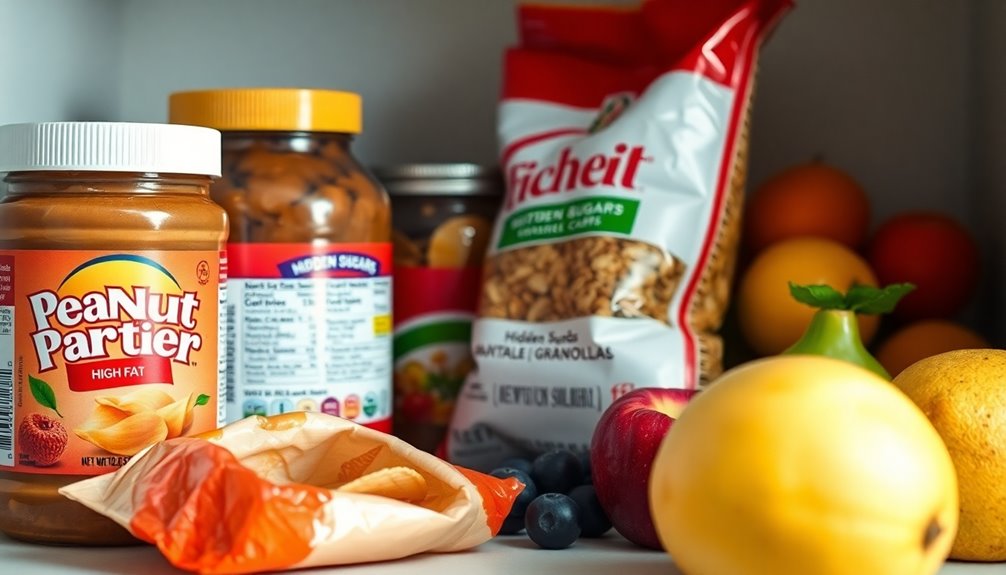To spot hidden fats and carbs in your diet, pay close attention to ingredient lists and nutrition labels. Look for red flags like palm oil, high-fructose corn syrup, and ingredients with long names. Check the serving sizes to avoid underestimating calorie and carb intake. Don't be fooled by low-fat or gluten-free claims; they often contain added sugars and unhealthy substitutes. Sauces, dressings, and seemingly healthy snacks can pack in unwanted hidden calories. Focus on whole, minimally processed foods for better control. Discovering these tricks can help you make informed choices for a healthier lifestyle.
Key Takeaways
- Scrutinize ingredient lists for hidden additives like palm oil and high-fructose corn syrup that can contribute to unhealthy fats and carbs.
- Be wary of misleading health claims; check the actual nutritional content rather than relying solely on marketing.
- Pay attention to serving sizes to accurately assess the calorie and carb content of foods.
- Opt for whole, minimally processed foods with short ingredient lists to minimize hidden fats and carbs.
- Avoid sauces and dressings that may contain unexpected sugars and fats; make your own whenever possible.
Understanding Hidden Ingredients
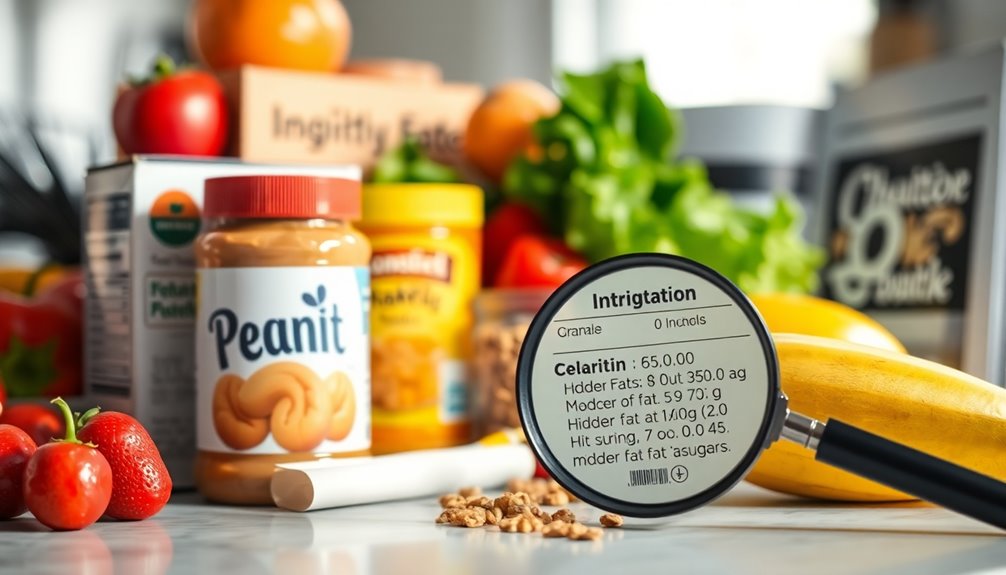
When you read food labels, you might be surprised to discover that many products contain hidden fats and carbohydrates that can derail your health goals. Ingredient deception is more common than you think. Many manufacturers use clever marketing tactics to make their products appear healthier than they actually are. For instance, they might highlight "low-fat" or "sugar-free" on the packaging, yet fail to mention the unseen additives that contribute to the overall calorie count.
These unseen additives can include thickeners, artificial sweeteners, or trans fats, which can sneak their way into your diet without you even realizing it. It's essential to scrutinize the ingredient list, as the first few items usually represent the most significant components of the product. If you see ingredients like palm oil or high-fructose corn syrup, it's a red flag—these often indicate hidden fats and sugars that can compromise your health goals.
To stay on track, try focusing on whole, minimally processed foods. Items with short ingredient lists and recognizable names are typically a safer bet.
When you commit to understanding the hidden ingredients in your food, you're not just taking control of your diet; you're also creating a sense of belonging within a community that values health and wellness. So, the next time you pick up a packaged item, remember to look beyond the label's claims and investigate deeper into what's really inside.
Reading Nutrition Labels
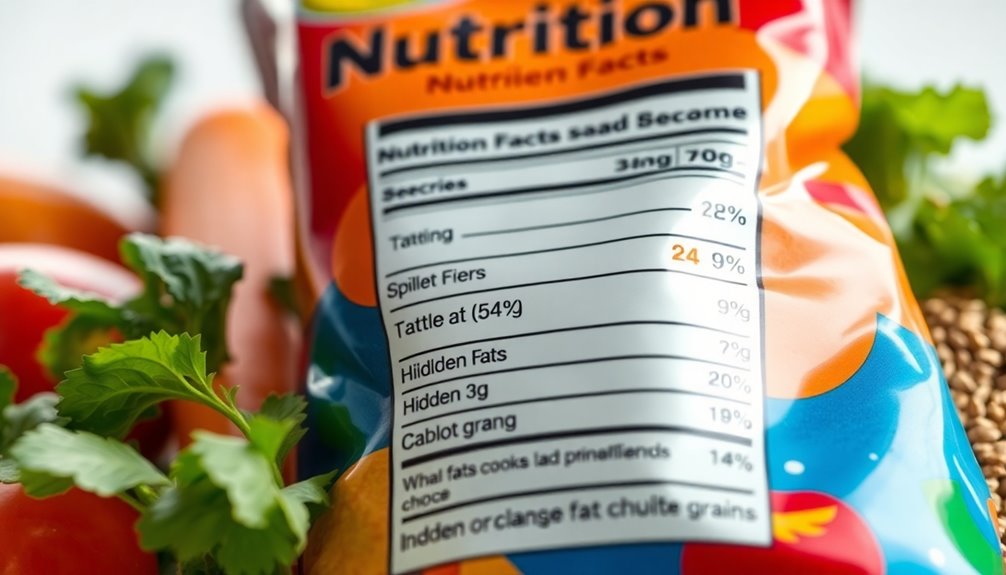
Reading nutrition labels can be your best tool in identifying hidden fats and carbs. These labels often contain label tricks that can mislead you if you don't know what to look for. By focusing on specific details, you can make informed choices about what you're consuming.
First, always check the serving size. It's easy to overlook this detail, leading you to underestimate the calories and carbs you're actually eating. Next, look at the total fat and carbohydrate content. Pay attention to the types of fat listed; saturated fat and trans fat are the ones you want to limit. Additionally, be aware that many gluten-free products can have high glycemic values, which can lead to unexpected blood sugar spikes.
Here's a quick reference table to help you spot these hidden elements:
| Nutrient Type | What to Look For | Common Label Tricks |
|---|---|---|
| Total Fat | Saturated & Trans Fat | "Fat-Free" claims |
| Total Carbohydrates | Sugars & Fiber | "Reduced Sugar" claims |
| Serving Size | Compare to your portion | "Per Serving" misleads |
| Ingredients List | Hidden sugars/fats | Long ingredient names |
| Nutritional Claims | "Heart-Healthy" claims | Misleading health claims
Common Food Misconceptions
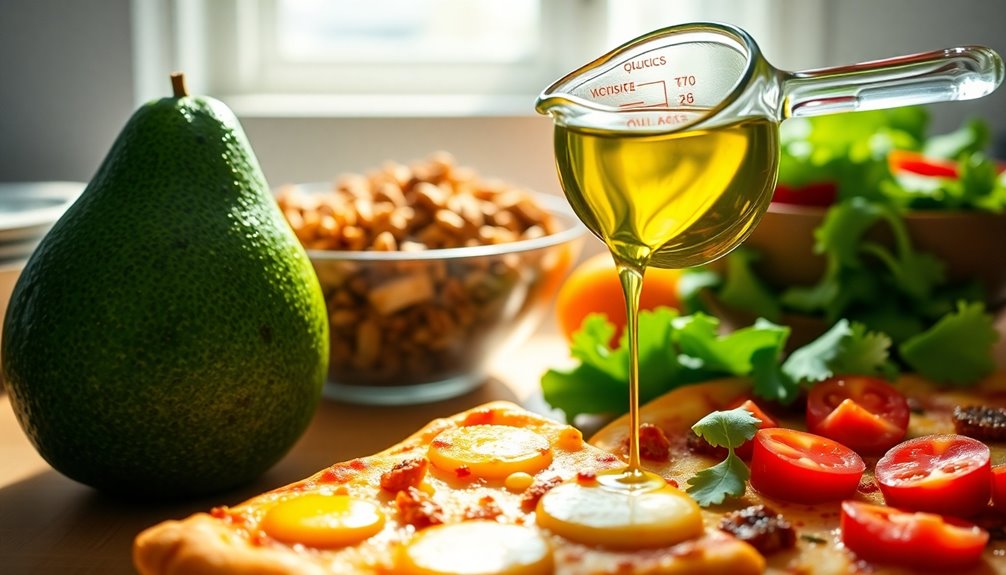
Misunderstanding the nutritional value of food can lead to poor dietary choices and unintended weight gain. Many people fall victim to popular myths surrounding food, which can skew your perception of what's healthy. For instance, you might think that all fats are bad for you. In reality, healthy fats found in avocados, nuts, and fish are essential for your body. Recognizing this dietary misconception is essential for making informed choices.
Another common misunderstanding is that low-carb diets are the only way to lose weight. While reducing carbs can help some individuals, it's important to take into account the quality of the carbohydrates you consume. Whole grains, fruits, and vegetables provide essential nutrients and fiber that processed carbs lack. Focusing solely on carb reduction can lead you to miss out on these crucial components of a balanced diet.
Additionally, many folks believe that if a food is labeled "fat-free," it's automatically healthy. This isn't always accurate. Often, manufacturers compensate for the lack of fat with added sugars or artificial ingredients, which can be just as harmful to your health. Understanding the importance of natural calorie cycles can help you make better choices that support overall well-being.
Sneaky Sources of Fats
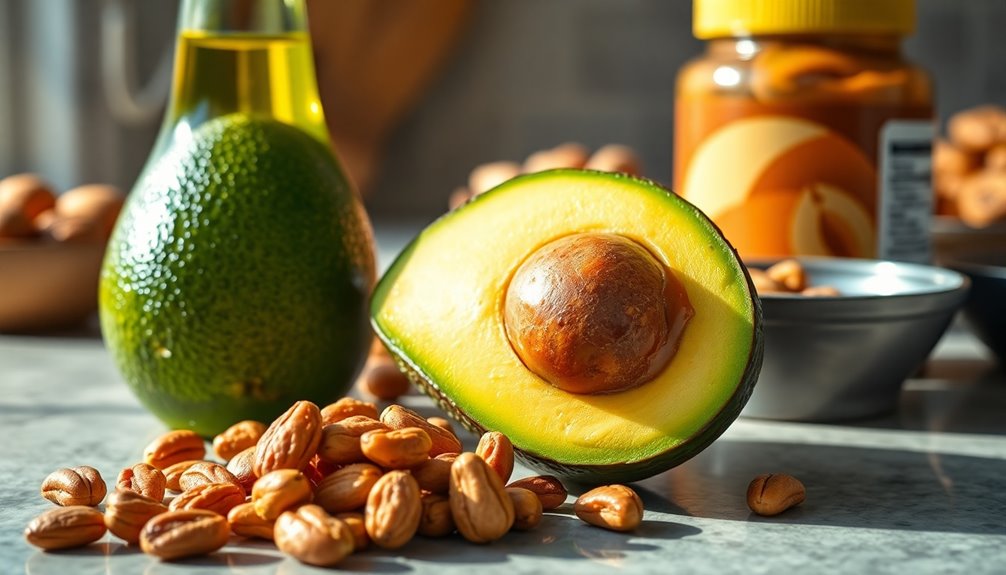
Hidden within many seemingly healthy foods are sneaky sources of fats that can derail your diet. When you're trying to make healthier choices, it's easy to overlook the fats lurking in unexpected places. Many cooking techniques contribute to this issue; for example, frying or sautéing can significantly increase fat content. Even if you start with a nutritious ingredient, the method you choose can transform it into a calorie-dense meal.
Portion sizes also play a vital role. A small handful of nuts might seem harmless, but those tiny portions can pack a hefty amount of fat. If you're unaware of how much you're actually consuming, you may find yourself exceeding your dietary goals without realizing it.
Similarly, dressings and sauces, often perceived as minor additions, can be sneaky culprits of hidden fats. A tablespoon of creamy dressing can add more fat than you'd expect, especially if you pour it generously.
To navigate these hidden sources effectively, always check labels and be mindful of how you prepare food. Opt for healthier cooking techniques like baking, steaming, or grilling instead of frying. Also, practice portion control; measuring out servings can help you stay on track. By being aware of these sneaky sources of fats, you'll make smarter choices that align with your health goals. Remember, it's not just about the foods you choose but also how you prepare and serve them. Additionally, incorporating whole food sources of protein into your meals can help you feel fuller and reduce the likelihood of overindulging in hidden fats.
Identifying Hidden Carbohydrates
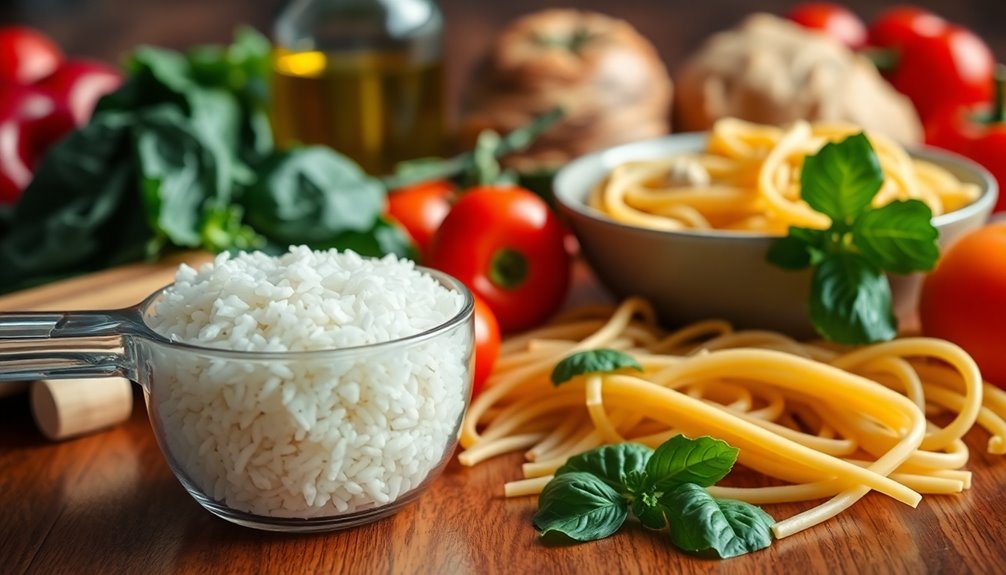
When you're trying to cut back on carbs, it can be surprising where they sneak into your diet. Many people focus on obvious sources like bread and pasta, but hidden carbohydrates can lurk in unexpected places.
For example, consider those seemingly innocent carb heavy snacks, often marketed as healthy. Granola bars, yogurt, and even certain brands of popcorn may contain more carbs than you think. Always check the nutrition label to see how many grams of carbohydrates are in each serving.
Another area to watch is those trendy sugar substitutes. While they're often touted as low-carb alternatives, some contain hidden sugars that can add up quickly. For instance, certain brands of sugar-free syrups or drinks might use ingredients like maltodextrin, which can spike your carb intake.
Additionally, sauces and dressings deserve your attention. Barbecue sauce, ketchup, and salad dressings can pack a surprising amount of sugar and carbs. Opt for homemade versions or choose items labeled as low-carb. Remember that many store-bought sauces may contain inflammatory ingredients that can undermine your health goals.
Lastly, be aware of portion sizes. Even healthy foods can contribute to hidden carbs if you eat them in large quantities. By being mindful and informed, you can better navigate your food choices and enjoy a balanced diet that aligns with your goals. Remember, knowledge is power, and the more you know about what's in your food, the easier it's to make choices that support your health.
Frequently Asked Questions
How Do Cooking Methods Affect the Fat Content in Food?
Cooking methods greatly affect the fat content in your food. For instance, baking generally uses less fat than frying, which can soak your food in oils. When you grill, excess fat drips away, making it a healthier choice, while sautéing often requires added oils that can increase fat content. By choosing baking and grilling over frying and sautéing, you can lower the fat levels in your meals, aligning with healthier eating habits.
Are There Healthier Alternatives to Hidden Fats and Carbs?
When you're browsing the grocery aisles, think of it as a treasure hunt for nutritious swaps. Instead of reaching for those heavy sauces, consider using Greek yogurt or avocado for creaminess without the guilt. Label reading becomes your compass—look for lower-fat options or whole grains.
You'll find that small changes, like choosing fresh veggies over chips, can light up your meals and help you feel part of a healthier community. Enjoy the journey!
How Can I Reduce Cravings for Hidden Sugars?
To reduce cravings for hidden sugars, consider using sugar substitutes like stevia or erythritol, which can satisfy your sweet tooth without the calories.
Practicing mindful eating helps you become more aware of your cravings and triggers, allowing you to make healthier choices.
Focus on enjoying whole foods and savoring each bite, which can diminish the urge for sugary snacks.
What Role Do Portion Sizes Play in Hidden Carbs?
Portion sizes greatly impact your carb intake. When you practice portion control, you become more aware of how many carbs you're consuming, which helps you avoid hidden sources.
For instance, a small serving of pasta might seem harmless, but larger portions can quickly add up. By measuring your servings and being mindful, you'll not only manage your carbs better but also foster a healthier relationship with food, making you feel more in control and connected.
How Often Should I Check for Hidden Fats in My Meals?
You should check for hidden fats in your meals frequently, ideally every time you prepare food. The impact of cooking methods can greatly alter fat content; frying, for example, can add unhealthy fats that you mightn't notice.
Conclusion
In maneuvering your diet, think of concealed fats and carbs as shadows that linger in your meals. By shining a light on ingredient lists and nutrition labels, you can reveal the truths behind your food choices. Remember, awareness is your compass; it guides you toward healthier decisions. As you become more attuned to these sneaky culprits, you'll find that your body flourishes, reflecting the clarity of your choices like a clear sky after a storm.

